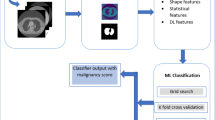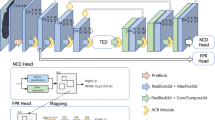Abstract
Lung cancer is one of the most critical diseases due to its significant death rate compared to all other types of cancer. The early diagnosis of lung cancer that improves the patient’s chance of surviving is mostly done in two phases: screening through CT scan imaging modality and, more importantly the medical expert’s reading of the scan, which is a time-consuming task and is vulnerable to errors. It is difficult to differentiate between malignant and benign nodules and biopsies are highly invasive, and patients with benign nodules may undergo unnecessary procedures. In this study, we propose a CNN-based computer-aided diagnosis system to automatically classify pulmonary nodules into benign or malignant. The proposed network architecture is based on AlexNet architecture that experiments with several types of layer ordering, hyperparameters, and functions for the various sides of the network. To build a well-trained model, several pre-processing steps are applied to the entire dataset, for instance segmentation, normalization, and zero centering. Finally, the proposed system obtained results with 98.7% accuracy, 98.6% sensitivity, and 98.9% specificity. The proposed model achieved superior performance compared to the AlexNet. The modifications in the original AlexNet is done to get a reasonable structure that has high nodule analysis sensitivity.
Graphical abstract









Similar content being viewed by others
References
American Cancer Society (2018) Key statistics for lung cancer. Am Cancer Soc. https://www.cancer.org/cancer/lungcancer/about/key-statistics.html. Accessed Feb 2019
Lakshmanaprabu SK, Mohanty SN, Shankar K, Arunkumar N, Ramirez G (2019) Optimal deep learning model for classification of lung cancer on CT images. Futur Gener Comput Syst 92:374–382. https://doi.org/10.1016/j.future.2018.10.009
da Silva GLF, Valente TLA, Silva AC, de Paiva AC, Gattass M (2018) Convolutional neural network-based PSO for lung nodule false positive reduction on CT images. Comput Methods Programs Biomed 162:109–118. https://doi.org/10.1016/j.cmpb.2018.05.006
da Nóbrega RVM, Rebouças Filho PP, Rodrigues MB, da Silva SPP, Dourado Júnior CMJM, de Albuquerque VHC (2018) Lung nodule malignancy classification in chest computed tomography images using transfer learning and convolutional neural networks. Neural Comput. https://link.springer.com/article/. https://doi.org/10.1007/s00521-018-3895-1. Accessed Feb 2019
Winkels M, Cohen TS (2019) Pulmonary nodule detection in CT scans with equivariant CNNs. Med Image Anal 55:15–26. https://doi.org/10.1016/j.media.2019.03.010
de Pinho Pinheiro CA, Nedjah N, de MacedoMourelle L (2019) Detection and classification of pulmonary nodules using deep learning and swarm intelligence. Multimed Tools Appl. https://doi.org/10.1007/s11042-019-7473-z
Xie Y, Xia Y, Zhang J, Song Y, Feng D, Fulham M, Cai W (2018) Knowledge-based collaborative deep learning for benign-malignant lung nodule classification on chest CT. IEEE Trans Med Imaging 1–1. https://pubmed.ncbi.nlm.nih.gov/30334786/. Accessed Feb 2019
Litjens G, Kooi T, Bejnordi BE, Setio AAA, Ciompi F, Ghafoorian M, van der Laak JAWM, van Ginneken B, Sánchez CI (2017) A survey on deep learning in medical image analysis. Med Image Anal 42:60–88. https://doi.org/10.1016/j.media.2017.07.005
Naqi SM, Sharif M, Jaffar A (2018) Lung nodule detection and classification based on geometric fit in parametric form and deep learning. Neural Comput Appl. https://link.springer.com/article/. https://doi.org/10.1007/s00521-018-3773-x . Accessed Feb 2019
Tran GS, Nghiem TP, Nguyen VT, Luong CM, Burie JC, Levin-Schwartz Y, Tran Thi Phuong AO, Nguyen AO, Thi V, Chi Mai L, Burie AO, Jean-Christophe AO-N (2019) Improving accuracy of lung nodule classification using deep learning with focal loss. J Healthc Eng. https://doi.org/10.1155/2019/5156416
Xie Y, Zhang J, Xia Y (2019) Semi-supervised adversarial model for benign-malignant lung nodule classification on chest CT. Med Image Anal. https://doi.org/10.1016/j.media.2019.07.004
Data Science Bowl | Kaggle (2017) https://www.kaggle.com/c/data-science-bowl-2019. Accessed Feb 2019
Armato SG, Drukker K, Li F, Hadjiiski L, Tourassi GD, Engelmann RM, Giger ML, Redmond G, Farahani K, Kirby JS, Clarke LP (2016) LUNGx challenge for computerized lung nodule classification. J Med Imaging 3:044506. https://www.ncbi.nlm.nih.gov/pmc/articles/PMC5166709/. Accessed Feb 2019
Krizhevsky A, Sutskever I, Hinton GE (2012) ImageNet classification with deep convolutional neural networks. Adv Neural Inf Process Syst 1097–1105. https://doi.org/10.1145/3065386
Acknowledgements
The authors gratefully acknowledge the financial support for this study from the Ministry of Higher Education and Scientific Research-Kurdistan Regional Government, Department of Computer, College of Science, University of Sulaimani, Sulaimani, Iraq, and we wish to give our full thanks and gratitude to the Kaggle Team and SPIE—with the support of the American Association of Physicists in Medicine (AAPM) and the National Cancer Institute (NCI), who prepared this useful dataset with its annotations and gave everyone the accessibility to download it.
Author information
Authors and Affiliations
Corresponding author
Additional information
Publisher's note
Springer Nature remains neutral with regard to jurisdictional claims in published maps and institutional affiliations.
Rights and permissions
About this article
Cite this article
Mahmood, S.A., Ahmed, H.A. An improved CNN-based architecture for automatic lung nodule classification. Med Biol Eng Comput 60, 1977–1986 (2022). https://doi.org/10.1007/s11517-022-02578-0
Received:
Accepted:
Published:
Issue Date:
DOI: https://doi.org/10.1007/s11517-022-02578-0




